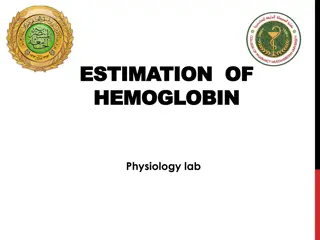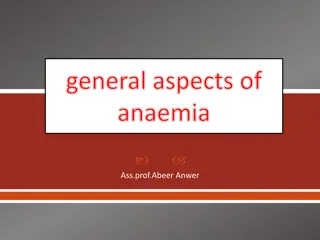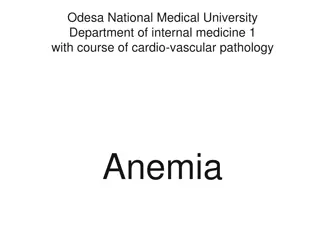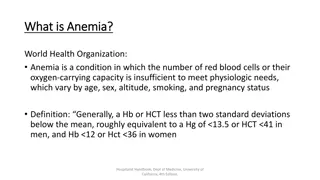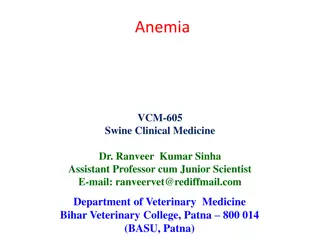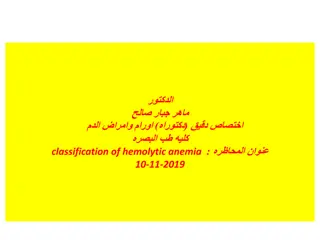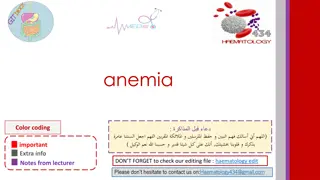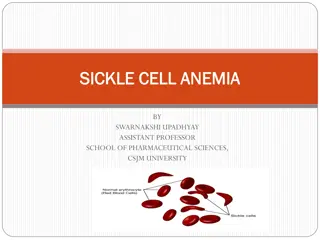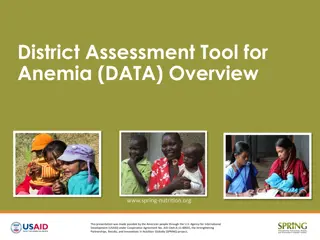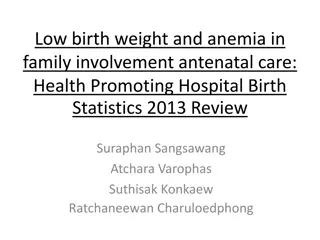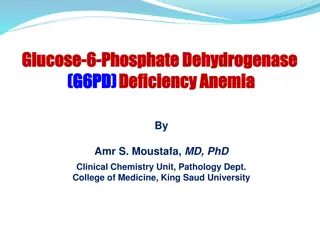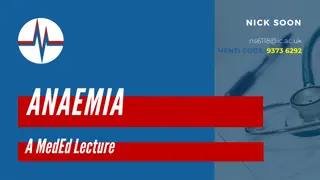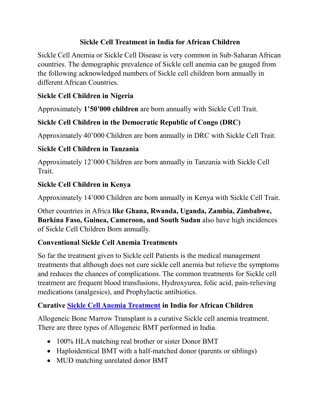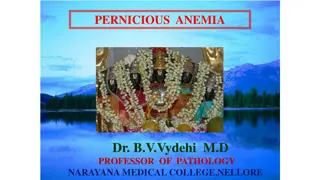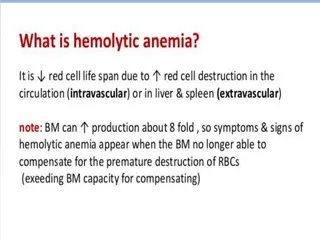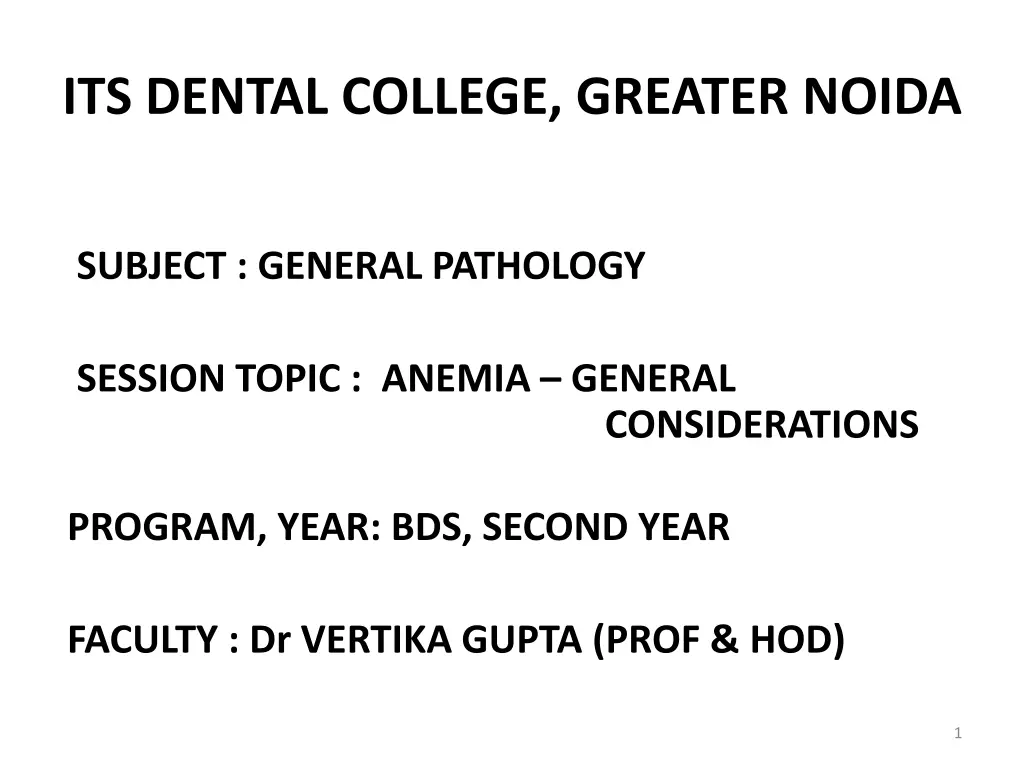
Understanding Anemia: Introduction, Classification, and Clinical Features
Explore the concept of anemia, its definition, pathophysiology, clinical features, and specific signs associated with different types of anemia. Learn about the impact of reduced hemoglobin levels on the body and how it manifests in various systems. Gain insights into the classification of anemia and understand the importance of RBC indices in diagnosis and management.
Download Presentation

Please find below an Image/Link to download the presentation.
The content on the website is provided AS IS for your information and personal use only. It may not be sold, licensed, or shared on other websites without obtaining consent from the author. If you encounter any issues during the download, it is possible that the publisher has removed the file from their server.
You are allowed to download the files provided on this website for personal or commercial use, subject to the condition that they are used lawfully. All files are the property of their respective owners.
The content on the website is provided AS IS for your information and personal use only. It may not be sold, licensed, or shared on other websites without obtaining consent from the author.
E N D
Presentation Transcript
ITS DENTAL COLLEGE, GREATER NOIDA SUBJECT : GENERAL PATHOLOGY SESSION TOPIC : ANEMIA GENERAL CONSIDERATIONS PROGRAM, YEAR: BDS, SECOND YEAR FACULTY : Dr VERTIKA GUPTA (PROF & HOD) 1
Learning Objectives & Specific Learning Outcomes General Objectives: To describe anaemia with emphasis on introduction & classification. Specific Learning Outcomes: At the end of the lecture, the learner should have the knowledge about anaemia with respect to 1) Definition & pathophysiology of anaemia 2) Clinical features of anemia 3) Classification of anaemia 4) RBC Indices 2
Anaemia is derived from the GREEK word (an-hama) meaning "without blood, & is defined as -Reduction of hemoglobin concentration below reference value Or - Reduction below normal limits of total circulating red cell mass. NORMAL Hb LEVELS (Males) : 13.6 17.2 gm/dl (Females) : 12.0 15.0 gm/dl
PATHOPHYSIOLOGY Subnormal levels of Hb O carrying capacity of bld Eventually, ts hypoxia develops impaired func of affected ts
CLINICAL FEATURES 1. PALLOR mucous membrane, conjunctiva , skin & nail beds
2.TIREDNESS, WEAKNESS, LASSITUDE, MALAISE & EASY FATIGABILITY 3. NAILS brittle, kolionychia
4. CVS (hyperdynamic circulation) - Tachycardia , collapsing pulse, cardiomegaly, elderly (angina pectoris & CHF) 5. CNS - giddiness, headache, tinnitus, drowsiness, numbness & tingling ( hands & feet) 6. REPRODUCTIVE SYSTEM - Menstrual disturbances, loss of libido
7. RENAL SYSTEM - Mild proteinuria, impaired concentrating capacity of kidney 8. G.I SYSTEM - nausea, anorexia, flatulence, constipation, wt loss SPECIFIC S/S WITH SPECIFIC ANAEMIAS
Red Cell Indices Mean corpuscular volume (MCV): MCV represents the average volume of a single red cell. Mean corpuscular haemoglobin (MCH): This is the average amount of haemoglobin in each red cell.
Mean corpuscular haemoglobin concentration (MCHC): This represents the average concentration of haemoglobin in a given volume of packed red cells Red cell distribution width (RDW): RDW is the degree of variation of red cell size
CLASSIFICATION OF ANAEMIAS PATHOPHYSIOLOGIC MORPHOLOGIC
PATHOPHYSIOLOGIC CLASSIFICATION 1) Anaemia Due To Increased Blood Loss Acute - trauma Chronic blood loss - lesions of GI tract, gynecologic disturbances
2 ) Anaemia Due To Impaired Red Cell Production A) Disturbance of proliferation & maturation of erythroblast Defective Hb synthesis(cytoplasmic maturation defects) - Deficient heme synthesis - Iron Deficiency Anaemia - Deficient Globin Synthesis - Thalassaemia Defective DNA synthesis (nuclear maturation defects) - Vitamin B12 and folic acid deficiency -Megaloblastic A B) Defect in stem cell proliferation and differentiation i) Aplastic Anaemia ii) Pure red cell aplasia syndromes
C) Anaemia of chronic disorders. D) Bone marrow infiltration. E) Congenital anaemia 3) Anaemias due to increased red cell destruction {haemolytic anaemias}. A. Extrinsic [extracorpuscular] red cell abnormalities. B. Intrinsic (intracorpusclar) red cell abnormalities
I. Intrinsic Red cell abnormality (Intracorpuscular factors) A. Hereditary 1. RBC Membrane defects - Hereditary spherocytosis - Heriditary elliptocytosis 2. RBC enzyme defects Enzymes of hexose monoPO shunt - G6PD deficiency Glycolytic enzymes - Pyruvate kinase deficiency - hexokinase deficiency
3. Disorders of Hb synthesis Deficient globin syn Thalassemia syndromes Hemoglobinopathies - Unstable hemoglobins - Sickle cell anemia B. Acquired 1. Membrane abnormality -Paroxysmal nocturnal hemoglobinuria (PNH)
II. Extrinsic Red cell abnormality (Extracorpuscular factors ) A. Antibody: Immune hemolytic anemias 1. Autoimmune hemolytic anemia - Warm antibody AIHA - Cold antibody AIHA 2. Drug induced IHA 3. Isoimmune hemolytic anaemia transfusion reactions, immune hydrops
2. Hemolysis due to mechanical trauma Microangiopathic HA Hemolytic uremic syndrome (HUS) Thrombotic thrombocytopenic purpura (TTP Prosthetic heart valves 3. Direct toxic effects : malaria
MORPHOLOGIC CLASSIFICATION :- 1. Microcytic , Hypochromic MCV, MCH, MCHC - IDA, Thalassemia, Sideoblastic anaemia 2. Normocytic , Normochromic MCV, MCH, MCHC normal Acute bld loss, Anaemia of chronic dis, Hemolytic Anemias 3. Macrocytic , Normochromic MCV , Megaloblastic anaemia
Frequently asked Questions 1) Define anaemia. Write the classification of anaemia. 21
Reading List/Reference List Robbins Basic Pathology: Kumar, Abbas, Aster, 9th Edition Essential Pathology for Dental Students: Harsh Mohan, Sugandha Mohan, 5th Edition 22

